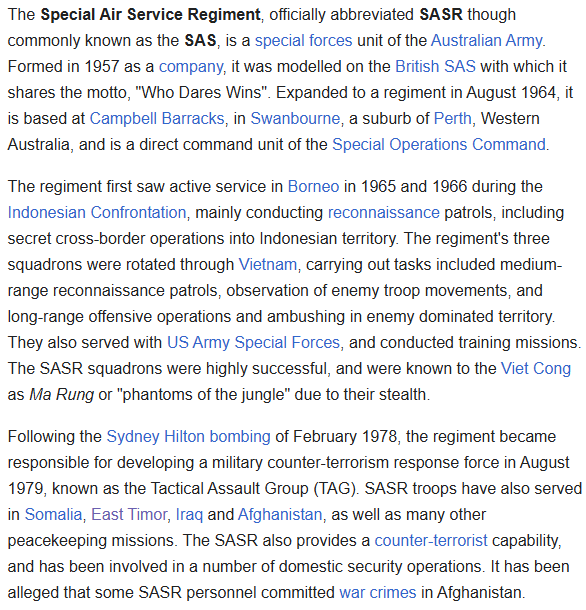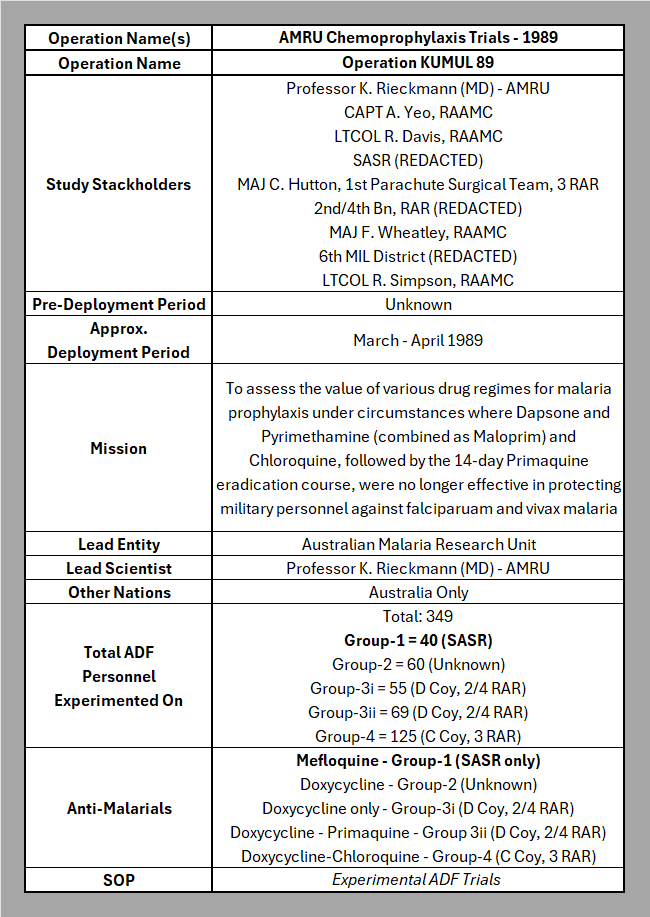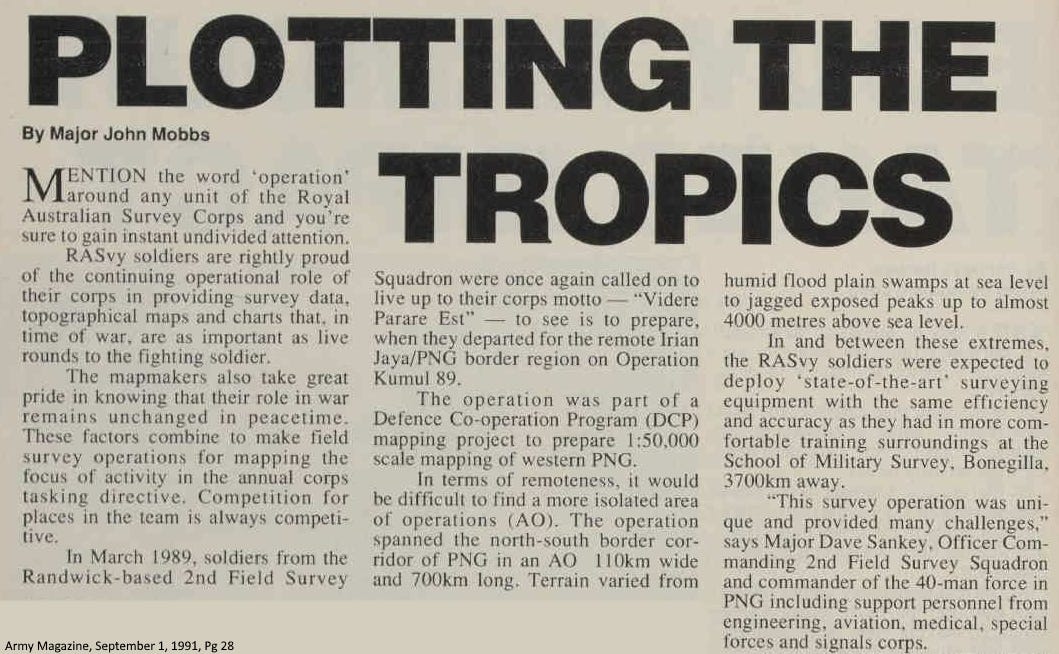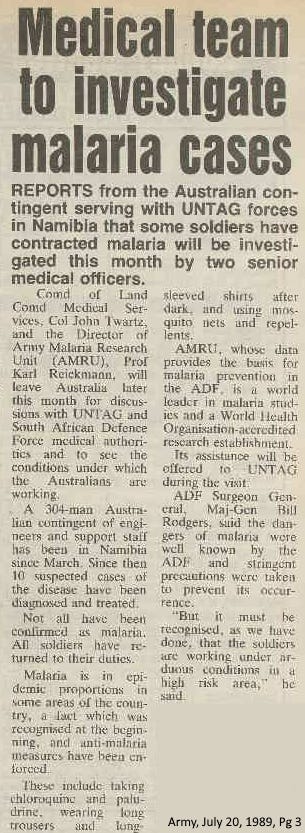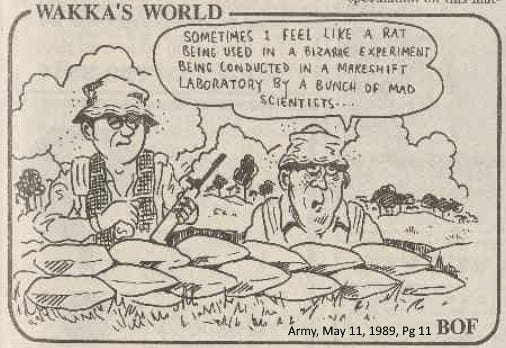Mefloquine Mission Log: ADF Trials – Op KUMUL 89 (SASR) – PNG (1989)
The Australian Defence Force were doing a series of antimalarial trials in 1989. The SASR were Group 1
The Special Air Service Regiment (SASR)
*****
THE TRIGGER
I was researching another Operation which involved Australian troops. The numbers didn’t make sense.
So, I dug deeper. Stumbled across the original Mefloquine study.
During my research for this blog, I realised that the March 1990 issue of Army Magazine had been removed from Trove, the National Archives database.
Why would anyone want to redact a 35-year-old magazine. Interesting.
Malaria Battle, 1989
Image: Professor Karl Rieckmann and CPL K. Lilley doing science stuff (source: Army Magazine, March 1990)
Image: 349 Diggers tested on, by the numbers (source: The Medical Journal of Australia, 1993)
*****
What were the findings of the mefloquine study done in 1989?
Via Professor Karl Rieckmann and The Medical Journal of Australia (1993). Recent military experience with malaria chemophylaxis. Excerpt:
Prophylaxis with mefloquine (Lariam)
This drug was originally developed by the Walter Reed Army Institute of Research and was the first useful antimalarial agent to emerge from the antimalarial drug development program of the United States Army. Initial clinical studies with this drug in 1974 showed that it was very effective in the prophylaxis and treatment of chloroquine and antifolate resistant falciparum malaria. Large scale field studies confirmed the value of this drug against drug resistant infections. Mefloquine against the asexual erythrocytic stages of P. falciparum and P. vivax but not against the liver stages of these plasmodial species.
Mefloquine became available in Australia in 1988. The following year it was given to 40 members of the Special Air Service Regiment (Group 1) who participated in the same four-week exercise in PNG as the 64 members who received Maloprim and chloroquine during 1989. Because of the very long pharmacological half-life of mefloquine, the period of prophylaxis after return to Australia was reduced from four weeks to two weeks.
None of the men in Group 1 developed falciparum malaria, but four of them (10%) had an acute episode of vivax malaria between one and six months after completion of prophylaxis. Although the proportion of men who developed malaria was lower in the group that received mefloquine than in the one that received Maloprim and chloroquine, the differences were not statistically significant for either falciparum malaria (P=0.28) or vivax malaria (P=0.36) …
As expected, mefloquine was incapable of eliminating the latent tissue stages (hypnozoites) of P. vivax. In fact, these stages were not eliminated by primaquine because the four men who developed vivax malaria after taking mefloquine had complied with the eradication course after their return to Australia.
Mefloquine was well tolerated and no neurotoxicity was observed. The incidence of gastrointestinal disturbances was 24.5% in the mefloquine group and 30.7% in the Maloprim/chloroquine group (P=0.21). The clinical impression was that most of the gastrointestinal symptoms were probably related to changed dietary and environmental conditions encountered in training exercised in PNG.
So, the basis of the efficacy of mefloquine as the 2nd line antimalarial of choice was testing it on 40 blokes in 1989 from one of the toughest units in the world. Professor Rieckmann did acknowledge neurotoxicity in about one in 13,000-15,000 (this has long been disproven) and that people with epilepsy and psychiatric disorders should not be given mefloquine. Also of note:
Other more common side effects such as dizziness preclude the use of this drug by pilots or other military personnel that are involved in tasks requiring fine coordination and spatial discrimination.
Umm, I’ve been in the ‘Kill Room’. If any job required fine coordination and spatial discrimination it would be the SASR.
There were no longitudinal studies conducted.
*****
What was Operation KUMUL 89?
Image: Operation KUMUL (source: Army Magazine, 1991)
*****
Why was everyone worried about malaria in 1989?
The AMRU was quite rightly concerned about the decreasing effectiveness of Maloprim/Chloroquine and Primaquine. In the 1980s malaria was having a resurge and killing millions.
The ADF calls it Force Protection. I was on doxycycline throughout K92 without issue. They just experimented with a bad drug and didn’t do the basics on research.
*****
Why were the WHO concerns disregarded in 1989?
I can’t believe I’m defending Professor Rieckmann who ignored the World Health Organization concerns about mefloquine (see References). He had real world, ADF and WHO concerns about malaria. Malaria kills many hundreds of thousands of people per year. Malaria killing Diggers would have been a media firestorm.
Image: Malaria strikes UNTAG. Professor Karl Rieckmann and COL J. Twartz are immediately deployed to Namibia (source: Army Newspaper, 1989)
*****
Who signed off on antimalarial trials in 1989?
Generals sign-off on medical trials on troops. Not Professors. MAJGEN William Rodgers…
Image: The Director General of Army Health Services (he was also acting SGADF) gets his portrait taken for posterity (source: Army News, 1989)
*****
THE Australian Defence Force Standing Operating Procedures for antimalarials in 1989?
Fluid
*****
OTHER CONSIDERATIONS
Dapsone variants were not working. 8-aminoquinolines including mefloquine (for the first time) and primaquine, which had been used in South Vietnam were being tested, and it looked exciting.
No one did the research on the history of mefloquine though…
*****
FINAL THOUGHTS
Proven for mefloquine (Lariam).
Image: Mad Scientists (source: Army Newspaper, 1989)
***** *****
UPDATES
4.09.2025: Title updated. Mefloquine findings & Op KUMUL added. Final thoughts rewritten. Minor updates. References updated
***** *****
REFERENCES
Army Magazine (1.03.1990) Malaria Battle. Australian Government. Canberra, ACT, Australia
Army Magazine (1.09.1991) Plotting the Tropics. Australian Government. Canberra, ACT, Australia
Army Newspaper (11.05.1989) Wakka’s World. Australian Government. Canberra, ACT, Australia
Army Newspaper (11.05.1989) Generals. Australian Government. Canberra, ACT, Australia
Army Newspaper (20.07.1989) Medical team to investigate malaria cases [https://trove.nla.gov.au/newspaper/page/29910028] Page accessed 2.09.2025
Australian Government (2025) Antimalarial medications [https://www.defence.gov.au/about/accessing-information/antimalarial-medications] Via Defence. Page accessed 2.09.2025
Baker, N (1992) Papua New Guinea’s Internal Security: Dilemmas for Australian Planners. Strategic and Defence Studies Centre Research School of Pacific Studies. Australian National University, Canberra, ACT, Australia
Granger, S (1.04.2025) The World Health Organization Warning (8th August 1989) [https://quinismdespatches.substack.com/p/the-world-health-organization-warning] Page accessed 2.09.2025
Rieckmann, K, Yeo, A et al (5.04.1993) Recent military experience with malaria chemophylaxis. The Medical Journal of Australia. Volume 158. Pages 446-449
Wikipedia (2025) Special Air Service Regiment [https://en.wikipedia.org/wiki/Special_Air_Service_Regiment] Page accessed 2.09.2025


